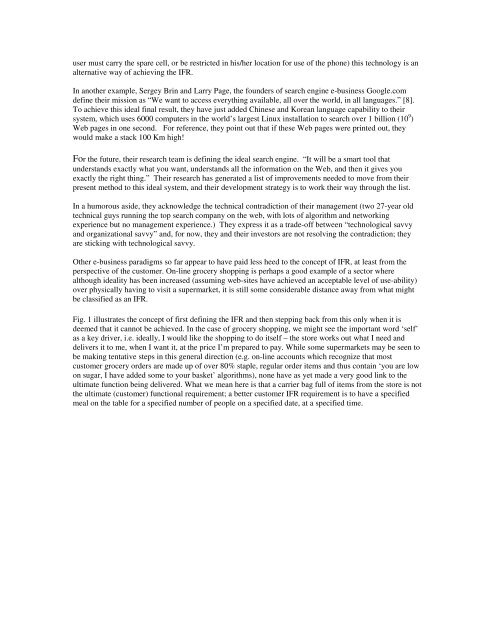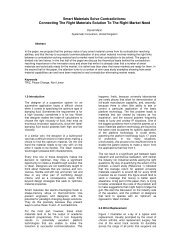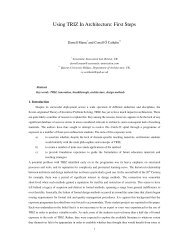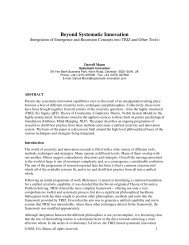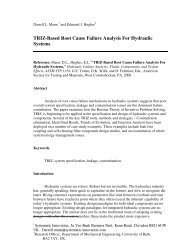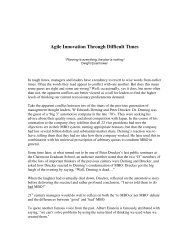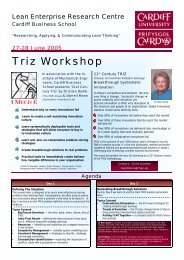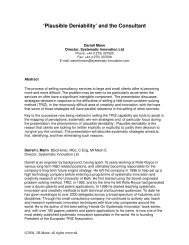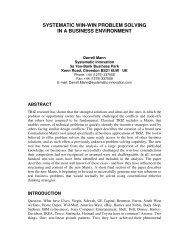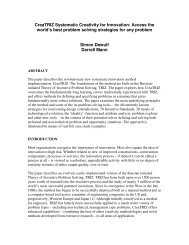TRIZ in the Knowledge Era: Achieving Profitable E-Commerce
TRIZ in the Knowledge Era: Achieving Profitable E-Commerce
TRIZ in the Knowledge Era: Achieving Profitable E-Commerce
You also want an ePaper? Increase the reach of your titles
YUMPU automatically turns print PDFs into web optimized ePapers that Google loves.
user must carry <strong>the</strong> spare cell, or be restricted <strong>in</strong> his/her location for use of <strong>the</strong> phone) this technology is an<br />
alternative way of achiev<strong>in</strong>g <strong>the</strong> IFR.<br />
In ano<strong>the</strong>r example, Sergey Br<strong>in</strong> and Larry Page, <strong>the</strong> founders of search eng<strong>in</strong>e e-bus<strong>in</strong>ess Google.com<br />
def<strong>in</strong>e <strong>the</strong>ir mission as “We want to access everyth<strong>in</strong>g available, all over <strong>the</strong> world, <strong>in</strong> all languages.” [8].<br />
To achieve this ideal f<strong>in</strong>al result, <strong>the</strong>y have just added Ch<strong>in</strong>ese and Korean language capability to <strong>the</strong>ir<br />
system, which uses 6000 computers <strong>in</strong> <strong>the</strong> world’s largest L<strong>in</strong>ux <strong>in</strong>stallation to search over 1 billion (10 9 )<br />
Web pages <strong>in</strong> one second. For reference, <strong>the</strong>y po<strong>in</strong>t out that if <strong>the</strong>se Web pages were pr<strong>in</strong>ted out, <strong>the</strong>y<br />
would make a stack 100 Km high!<br />
For <strong>the</strong> future, <strong>the</strong>ir research team is def<strong>in</strong><strong>in</strong>g <strong>the</strong> ideal search eng<strong>in</strong>e. “It will be a smart tool that<br />
understands exactly what you want, understands all <strong>the</strong> <strong>in</strong>formation on <strong>the</strong> Web, and <strong>the</strong>n it gives you<br />
exactly <strong>the</strong> right th<strong>in</strong>g.” Their research has generated a list of improvements needed to move from <strong>the</strong>ir<br />
present method to this ideal system, and <strong>the</strong>ir development strategy is to work <strong>the</strong>ir way through <strong>the</strong> list.<br />
In a humorous aside, <strong>the</strong>y acknowledge <strong>the</strong> technical contradiction of <strong>the</strong>ir management (two 27-year old<br />
technical guys runn<strong>in</strong>g <strong>the</strong> top search company on <strong>the</strong> web, with lots of algorithm and network<strong>in</strong>g<br />
experience but no management experience.) They express it as a trade-off between “technological savvy<br />
and organizational savvy” and, for now, <strong>the</strong>y and <strong>the</strong>ir <strong>in</strong>vestors are not resolv<strong>in</strong>g <strong>the</strong> contradiction; <strong>the</strong>y<br />
are stick<strong>in</strong>g with technological savvy.<br />
O<strong>the</strong>r e-bus<strong>in</strong>ess paradigms so far appear to have paid less heed to <strong>the</strong> concept of IFR, at least from <strong>the</strong><br />
perspective of <strong>the</strong> customer. On-l<strong>in</strong>e grocery shopp<strong>in</strong>g is perhaps a good example of a sector where<br />
although ideality has been <strong>in</strong>creased (assum<strong>in</strong>g web-sites have achieved an acceptable level of use-ability)<br />
over physically hav<strong>in</strong>g to visit a supermarket, it is still some considerable distance away from what might<br />
be classified as an IFR.<br />
Fig. 1 illustrates <strong>the</strong> concept of first def<strong>in</strong><strong>in</strong>g <strong>the</strong> IFR and <strong>the</strong>n stepp<strong>in</strong>g back from this only when it is<br />
deemed that it cannot be achieved. In <strong>the</strong> case of grocery shopp<strong>in</strong>g, we might see <strong>the</strong> important word ‘self’<br />
as a key driver, i.e. ideally, I would like <strong>the</strong> shopp<strong>in</strong>g to do itself – <strong>the</strong> store works out what I need and<br />
delivers it to me, when I want it, at <strong>the</strong> price I’m prepared to pay. While some supermarkets may be seen to<br />
be mak<strong>in</strong>g tentative steps <strong>in</strong> this general direction (e.g. on-l<strong>in</strong>e accounts which recognize that most<br />
customer grocery orders are made up of over 80% staple, regular order items and thus conta<strong>in</strong> ‘you are low<br />
on sugar, I have added some to your basket’ algorithms), none have as yet made a very good l<strong>in</strong>k to <strong>the</strong><br />
ultimate function be<strong>in</strong>g delivered. What we mean here is that a carrier bag full of items from <strong>the</strong> store is not<br />
<strong>the</strong> ultimate (customer) functional requirement; a better customer IFR requirement is to have a specified<br />
meal on <strong>the</strong> table for a specified number of people on a specified date, at a specified time.


